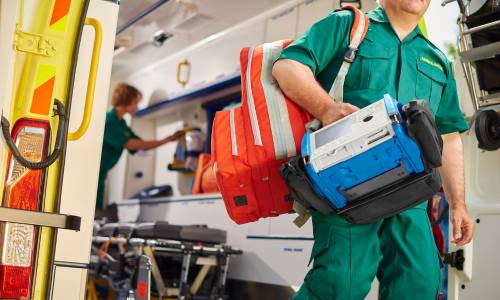Emergency Services Day recognises the hard work and dedication of our urgent care provisions, including NHS ambulance teams. This year, we’re highlighting how seven ambulance trusts up and down the UK use Consultant Connect to speak rapidly and directly with clinicians to discuss whether A&E is the most suitable destination for their patients. Enabling 36% of all calls to avoid unnecessary patient conveyances, rapid telephone advice via Consultant Connect provides ambulance clinicians with a single point of access to a rota of specialists, minimising the number of missed or unanswered queries.
Below are three examples of how our services are supporting ambulance clinicians across the NHS in providing the best patient care:
Scottish Ambulance Service (SAS)
SAS uses Consultant Connect to obtain rapid prof-to-prof telephone advice within four health boards: Greater Glasgow and Clyde, Tayside, Lanarkshire, and Forth Valley. First launched in Tayside in 2019, today, 17 lines are available across the four health boards, with more than 100,000 calls placed by SAS. The service sees around 2,000 calls placed per month, answered within 16 seconds on average, resulting in 28% of patients avoiding an unnecessary hospital conveyance.
One line available to SAS is the ‘call before convey’ pathway in Lanarkshire, allowing clinicians to contact ED colleagues in the Flow Navigation Centre directly. Calls are either connected to an ED consultant or an advanced paramedic practitioner. The initiative enables clinicians to discuss patients with non-life-threatening conditions rapidly, deciding on the best clinical destination, often bypassing ED.
‘I use it all the time, especially at night; because we’re lone workers, it’s a valuable link to access another level of decision-making. It’s great that we can contact our emergency medicine colleagues in this way to support our decisions and access patient notes. It’s like having the specialist sat next to you, and they have access to other information you might not.’
– Sharleen Johnston, Advanced Nurse Practitioner.
Welsh Ambulance Services University NHS Trust (WAST)
Launched in 2020, Consultant Connect is available to all NHS clinicians across Wales, making WAST the first ambulance organisation to have access to the service countrywide. Across all seven health boards, WAST clinicians have access to rapid telephone advice from up to 61 specialties (depending on their locality), with calls being answered within seven seconds and clinicians placing 3,500 calls each month on average. This results in 31% of patients avoiding an unnecessary hospital visit.
‘The Consultant Connect App is really easy to use, and it’s great because all the numbers are in one place. It’s also safe from an IG aspect, as it is encrypted, calls are recorded, and they can be easily accessed should there be a need. If the patient is seriously ill, then it’s the pre-alert lines that I would use, and it’s just a quick couple of taps on the app to be put through to the receiving ED, who knows straight away what to expect when the patient arrives.’
– Marcus Viggers, Paramedic for WAST.
As well as rapid telephone advice, WAST clinicians also have access to Bypass Numbers for same-day emergency communications, allowing users to skip the queue on switchboard and speak directly to staff at local GP practices:
‘The are numerous examples of patients who have benefited from us having access to this service: patients for whom, due to their comorbidities, hospital is not the best place for their care can stay at home because we can contact their GP. Recently, I visited a patient who was really unwell from the side effects of cancer treatment, but because they were immunocompromised, we didn’t want to transfer them to hospital. I used the Bypass Numbers feature on the Consultant Connect App to speak with their GP, who knew the patient’s history well, and arranged for them to conduct a home visit the same day. This meant the patient could stay at home, avoiding a likely very busy A&E department with long waiting times where they would be susceptible to infection. Instead, they could be close to their own facilities and assessed by their GP on the same day for medication. This was invaluable and definitely would have been a better experience for the patient and their relatives.’
– Shaun Martin-Brand, EMT for WAST.
South Central Ambulance Service NHS Foundation Trust (SCAS)
The project has enabled SCAS clinicians to utilise Consultant Connect as a pre-programmed service directory to communicate with NHS colleagues across the Milton Keynes and Buckinghamshire areas since 2019. The service routes 300 calls per month within 41 seconds on average, enabling 35% of patients to be treated outside of hospital.
‘The success of the project has been so apparent that the acute trust is now looking to implement Consultant Connect services to support and develop a single point of access that would operate 12 hours a day, seven days a week.’
– Joe Matthews, Senior Urgent and Emergency Care Lead, NHS Buckinghamshire, Oxfordshire and Berkshire West (BOB ICB).
* Stats correct as of June 2024.
If you want to discuss setting up a Consultant Connect project, please email hello@consultantconnect.org.uk or call 01865 261467.
Related materials:
- ‘Call before convey’ in NHS Lanarkshire: six months in
- 5 minutes with… the Flow Navigation Centre clinicians in NHS Lanarkshire
- 5 minutes with… a paramedic in Wales
- How Consultant Connect tech enabled WAST clinicians to avoid hospital visit for vulnerable cancer patient
- Using Consultant Connect for Frailty pathways
